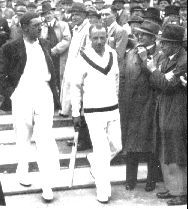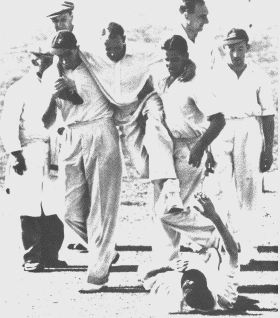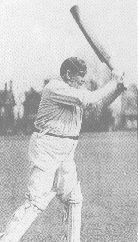Sheranga's Cricket Hall of Fame
Contents




MORE COMING SOON!
The cricketers are in no particular order. To view the images seperately, click on the image
with your right mouse button and view it as a jpg or gif file.

SIR DONALD GEORGE BRADMAN
COUNTRY-AUSTRALIA
BORN-AUGUST 27th 1908
Born in the small town of Cootamundra, NSW, Sir Donald George
Bradman is undisputedly the greatest batsman of all time. His test
average of 99.94 is head and shoulders above anyone else. The next
closest is C.S Dempster with a meagre 65.72!
As a young boy, Don would throw a golf ball against a water tank
and hit it at various angles. This sharpened his hand to eye
co-ordination and would serve a greater purpose in years to come.
At the age of seventeen Don played his first serious competitive
game for Bowral (where he had moved to in 1911). He made 234 and
immediately impressed. He was soon picked for the St George team and
in 1928 was picked for New South Wales for which he made 118 on debut
under oppressive conditions. After making three first-class centuries,
Bradman was picked for the Ashes side in 1928/29.
His first test was a flop and subsequently he was dropped for the
next test. He made a return in the third test making 79 and 112.
Australia lost the series but they were looking forward to the 1930 tour
with Bradman in ominous form. In the fifth test he made 123 and had made
a further nine first-class centuries. This inlcuded a 340 and a world
record 452. At this time he moved to Sydney for business commitments.
Bradman's and Australia's 1930 tour was remarkable. Australia
regained the Ashes 2-1 with Bradman breaking many records. He scored 1000
runs in May and 2690 on the whole tour. In the test series Bradman
amassed 974 runs at 139.14. This included innings of 254, 232 and 334. Bradman
describes his 254 as his best ever while his 334 was a world record.
Back in Australia Bradman had brilliant series against South Africa and
the West Indies. This together with a great domestic season further
established him as the greatest batsman. His personal life was going well
as he got married and secured commercial contracts. But in England, cricket's
hierachy were planning his demise.
When Jardine and his men came to Australia in 1932 for the Ashes, they
brought with them the "bodyline" or leg theory. This was the practice of
bowling bouncers at the batsman's body and stacking the leg side with fieldsmen.
Since this happened every ball the Australians saw it as unsportingly which
resulted in the severing of ties with England. A few serious injuries occured but thankfully
no one died. Harold Larwood was England's bodyline spearhead taking 32 wickets
for the series. By this tactic England subdued Bradman to 396 runs at 56.57 and
won the series. This is possibly cricket's darkest moment.
With Bradman continuing his phenomenal form, Australia was confident of
regaining the Ashes in England with the bodyline tactics out of the way.
In the previous season he had moved to South Australia, again for business
commitments. His form in England was the same as in 1930, scoring eight first-class
centuries (he scored ten in 1930). In the test series he "only" scored two centuries
but amassed 758 runs at 94.75. This included innings of 304 and 244. In scoring 304 he
broke the world record partnership with Bill Ponsford scoring 451 for the second wicket.
As Australia won the series 2-1 everything was going right for Bradman. This was until
late in the tour when he fell ill with a badly infected appendix. He went close to death
but finally recovered, ready to resume his career.
After recovering from his illness Bradman scored innings of 117, 233, 337 and 369.
In the season of 1936-37 he received the post of captain, ready to battle the poms.
He was also appointed as a selector, a job he took with some reservations. At the start
of the series Bradman made two successive ducks. It seemed the captaincy was putting too
much pressure on him. This was all put to rest after test innings of 270, 212 and 169.
Australia won the Ashes 3-2. In 1938 Bradman again toured England scoring 3 test centuries
and 13 all up. In the fourth test Australia suffered a terrible humiliation, losing by an innings and 579 runs,
the largest ever loss. England started of by making 7 dec for 903. Bradman bowled a few overs
and subsequently injured himself. The Australian batting then crumbled without Bradman. That
just showed how much Australia needed Bradman. However Australia retained the Ashes with
a 1-1 draw. With the outbreak of war in 1938, Bradman's illustrious career seemed over.
Bradman played brilliantly in the Sheffield Shield which continued into the war for a number of seasons.
In the war, Bradman joined the army but was forced to quit after ill health. In 1945 he started his own
business, a further reason to quit cricket. When test cricket started again in the summer of 1946-47,
Bradman decided to play on for a few more years as the Australian team desperately needed him.
It was a another great season for Bradman as he scored 680 runs at 113.33 in the test series.
It was in this summer which Bradman started his great rivalry with swing bowler Alec Bedser. Australia
won the series 3-0 which included two innings victories. The following season India played its first
test series against Australia. The Indians were outclassed losing 4 nil. Bradman smashed 715 runs at 178.75.
In 1948, Bradman sailed to England for one more tour before retiring from cricket. It was an exceptional series
to cap of his career. Australia won the series 4-0 which resulted in the 1948 Auustralian team being called the "invincibles".
Personally Bradman scored 508 runs at 72.57 in the test series. In his last test innings Bradman needed 4 runs (out) to have a
test average of 100. Amid great emotion, he was unfortunately dismissed for a second ball duck. Thus he ended up with an
average of 99.94. It was an anti climatic end for such a wonderful career.
The following year his testemonial match was held. It brought great attention as 90 000 people watched it.
In the same year he was knighted becoming Australia's only cricketing knight. He then became a cricketing administrator and held
many important postions. He has been honoured many times, the greatest being the inauguration of the Bradman Oval and museum in Bowral.
Through these institutions and many more, Sir Donald Bradman will be remembered as the greatest ever batsman in test history.
FIRST CLASS: 1927/28 to 1948
BATTING
M I NO RUNS HS AVE 100 50 CT/ST
234 338 43 28 067 452* 95.14 117 69 131/1
BOWLING
RUNS WKT AVE BEST 5WI 10WM
1367 36 37.97 3/35 0 0
AS CAPTAIN
P W D L T
120 61 45 13 1
TEST: 1928/29 TO 1948
M I NO RUNS HS AVE 100 50 CT/ST
52 80 10 6 996 334 99.94 29 13 32/0
RUNS WKT AVE BEST 5WI 10WM SR
72 2 36.00 1/8 0 0 80
AS CAPTAIN
P W D L T
24 15 6 3 -





WILLIAM GILBERT GRACE
COUNTRY-ENGLAND
BORN-JULY 18th 1848
DIED-OCTOBER 23rd 1915
Dr W.G Grace will be remembered as the father figure of cricket.
His huge stature made his presence felt immediately as he walked
upon each cricket ground. His figure with its characteristic
beard has made him one of cricket's and England's most famous
people. The number of years he played the game and the records
he achieved was a marvel of the game in the 19th century.
Born to a cricketing father - Dr Henry Mills Grace, William
and his brothers all followed their father's porfession. Two of
his brothers, E.M and G.F Grace played test cricket. As a young
boy, William's mother Martha taught him to play with a straight
bat. This all payed of for W.G when he was picked to play for the
Gentlemen at Lords. At the age of eighteen, W.G was about to
start a very long and successful career. Not only was W.G a great batsman, he was a good spinner. He was noted for the amount of flight he imparted on the ball.
From the time he walked onto the cricketing stage W.G revolutionised county cricket. Before his time the professionals dominated Gentlemen vs Players matches. After W.G's arrival, the Players won only 7 of the next 50 matches. He scored 15 centuries and took 126 wickets for the Gentlemen. In County cricket Grace led Gloucestershire to four championships. They haven't won any championships since then.
Perhaps his greatest year was 1871 where he smashed 2736 runs at 78. This might seem meagre to say Bradman's figures but let us remember at this was the 1870's. The pitches at that time were deplorable. The next best average for Gloucester was 34. That was the first instance of a player reaching 2000 runs in a season. A feat only equalled once by Frank Wooley. In the years 1872 and 1874 he took sides to North America and Australia respectively. In August 1876 he made 344, 177 and 318no. Soon afterwards in a second class match he made 400no against a side of 22 players.
In 1880 W.G made his test debut and in 1882 made England's first ever century. His test career may seem short and unimpressive now, but at that time was excellent. His highest score of 170 would be the highest for a test match in England for 35 years. From 1888 to 1899 he captained England.
W.G broke many a record. At he grand old age of 47 in 1895, W.G became the first man to score 1000 runs in May. In the same year he scored his 100th century. He became the first man to perform the double. That is to score 1000 runs and take 100 wickets in the same season. While his first-class aggregate was a record for some time, his record of scoring 1000 runs in a season 28 times has never been overtaken. In 1908 he finally retired from first class cricket becoming the longest serving cricketer.
Not only was he famous for his feats, his gamsmanship is the centre of cricketing folklore. His most famous event was when he was given out early in a county match. He refused to go out as he said, "They’ve come to see me bat, not you umpire. Play on!" When an Aboriginal team toured England in 1868 he was said to have joined the action by taking part in a spear and boomerang throwing contest. When he smashed the first four balls of James Shaw’s over to the boundary, Shaw explained "Oh, yes, he blocks the shooters, blocks ‘em to the boundary’."
Grace was not part of the aristrocracy and therefore not a true Gentlemen but was a doctor and therefore was not a proffesional. This situation and his great cricketing prowess brought the upper and lower classes together for the first time. Even though Grace played for the Gentlemen, he earned a fortune from cricket. It is said that he earned 1 million pounds from cricket. That in todays terms would be far greater than Lara’s or Tendulkar’s wealth or any other sportsman for that matter.
FIRST CLASS: 1865 to 1908
BATTING
M I NO RUNS HS AVE 100 CT/ST
869 1493 105 54 896 344 39.55 126 874/0
BOWLING
RUNS WKT AVE BEST 5WI 10WM
51545 2876 17.92 10-49 246 66
TEST: 1880 TO 1889
M I NO RUNS HS AVE 100 50 CT/ST
22 36 2 1098 170 32.29 2 5 39/0
RUNS WKT AVE BEST 5WI 10WM SR
236 9 26.22 2-12 0 0 74.0



My Favourite Site on the Net

Sign My Guestbook
View
My Guestbook

You are visitor
 to this page!
to this page!

|
 |
_NAME_ is part of the growing
Cricket Webring. If you have a cricket page, and would like to get more
exposure, just click Here.
Click here to go to
the page that made the Cricket Web Ring, An Aussie Cricket Page! |
Back|Back 2
List All Sites
Next|Next 2
|
Feel free to send your comments. Please suggest some links to add to my page.
© 1998 sfernando@techno.net.au

This page hosted by  Get your own Free Home Page
Get your own Free Home Page














to this page!


![]()